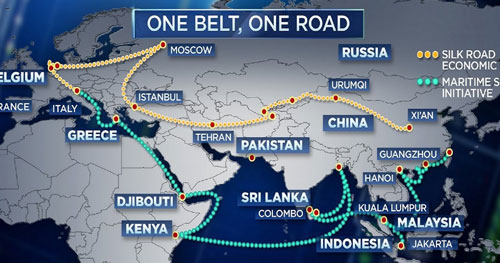One Belt One Road
Touted as Chinese President Xi Jinping’s brainchild, this ambitious project, the One Belt One Road initiative focuses on improving connectivity and cooperation among Asian countries, Africa, China and Europe. The emphasis is on enhancing land as well as maritime routes.
The policy is significant for China since it aims to boost domestic growth in the country. Experts have noted that OBOR is also a part of China’s strategy for economic diplomacy.
Considering China’s exclusion from G7, OBOR policy might just provide China an opportunity to continue its economic development.
Indian reaction towards the China-Pakistan Corridor has been one of hostility and opposition. The launch of CPEC has resulted in investment to the tune of USD 46 billion.
The Indian claim is that they oppose this project because it passes through Indian Territory meaning the areas of Kashmir under Pakistani control.
For Pakistan this gigantic project is a game changer. It is a critical necessity and a lifeline of future consequences that can help to lift our society out of poverty, misery, illiteracy and social conflict including unemployment. Apart from political differences one must give due credit where it is due.
The dream of this initiative was converted into reality by the regime of Nawaz Sharif who was the driving force behind this effort.
Minister of planning Ahsan Iqbal played a key role and Sartaj Aziz too did a yeoman service for pushing CPEC forward. Ironically the effort ran out of steam during the PPP govt.
and the Chinese showed little interest during this time and the project was stalled for many years.
One of the most important countries in this project is definitely Pakistan. Pakistan lies in very close proximity to China.
Pakistan is next door to the Chinese province of Xinjiang in the North at a height of over 15000 feet.
This provides China with a corridor through the Karakoram highway to the Pakistani seaport of Gwadar in Balochistan.
The Chinese Government plans to invest about 60 billion dollars in infrastructure developments in Pakistan.
Part of this amount will be in loans on soft terms which Pakistan will be under obligation to pay.
CPEC will result in the development of industrial parks, agricultural farms, railways, airports, highways, fibre optics network, energy generating projects and a high speed train between Karachi and Peshawar travelling at a speed of 160 km per hour.
This project will also build a brand new telecommunications network linking Pakistan with China and via China to Europe.
CEPEC will also result in the development of some initiatives of cultural and civic importance for example the safe city project, training the local police force and cultural improvement initiatives.
The anti-CPEC lobby in Pakistan and other countries have been very critical of this project and some have even called this initiative the second East India Company claiming that this will result in the colonization of Pakistan! Nothing could be further from the truth.
China has traded with many countries of South and southeast Asia for the last two thousand years.
They have traded with India for spices, with the Persians for gems, with Malaya, Sri Lanka.
Over two thousand years ago they were a mighty naval power and an economic powerhouse to contend with. Never once did they invade a country to rule over it.
Chinese merchants were very active in Malaysia and the volume of trade was astounding for the mutual benefit of both countries.
Admiral Zhenghe visited Malaysia five times leading a huge naval fleet he could have captured the country easily but he did not.
On the contrary, the Portuguese came in 1511, the Dutch in the 18th century and finally the British all these European countries colonized Malaysia one after the other.
The only time in history when China expanded beyond its defined borders was when Changez Khan and his descendants conquered huge lands in China, Asia, and Eastern Europe.
The Yuan Dynasty based in China was basically part of the Mongolian empire.
They came as far as the Indus in the sub-continent but never colonized the area that they could have done easily.
In 1900 China was attacked by the eight-nation alliance consisting of Russia, Britain, France, USA, Germany, Italy, Austro-Hungary and suffered the loss of lives and national treasures that ended up in Museums like the British Museum London and the Louvre in Paris.
Large parts of China such as Manchuria were occupied by Japan during WW-11 and suffered millions of casualties.
It was only in 1949 that China emerged from the ravages of war and destruction and under the leadership of giants like Mao and Chou en Lai that the People’s Republic of China was established.
All the progress and development in China is a result of back breaking labour and not by loot and plunder beyond their own borders.
In all their dealings with other countries the Chinese have shown decency, honesty and respect for the sovereign rights of all the nations they have dealt with.
Any doubts about the Chinese intentions or motives for the CPEC project should be put to rest once for all.







